The Complete Guide to Hiking in Iceland
Hiking in Iceland is an experience unlike any other. The island’s unspoiled, rugged landscape is so diverse that you’ll never run out of breathtaking natural spectacles to see.
You’ll wander over richly colored fields of lava, past hot springs and dreamy lakes, along craggy peaks with small glaciers.
Some hiking trails in Iceland run through sandy deserts, others over lush green meadows.
Whether it’s a hike in the highlands, a tour of a glacier or an ascent up a volcano, there is something for everyone here.
Warm-hearted Icelanders are delighted to meet respectful visitors who want to explore their homeland on foot, and they’ll be happy to spin a few enchanting elf tales for you!
Here’s an overview of the topics covered in this hiking guide to Iceland:
- Unique Wonders of Nature in Iceland
- Best Time To Go Hiking in Iceland
- Important Things To Know For Your Hiking Trip in Iceland
- Tips for Hiking in Iceland in Winter
- Planning Your Way to Northern Iceland
- Tips for Hiking Iceland in Summer
- Best Hikes in Iceland
- Recommended Hiking Gear for Iceland
1. Unique Wonders of Nature in Iceland

Hiking regions as spectacular as Iceland are hard to find. It’s one highlight after another here, so you’ll want to keep your camera handy.
Over half of the country lies 400 meters above sea level, and vast tracts are blanketed by lava and glaciers. Colorful mountains of rhyolite alternate with dreamy lakes.
Hiking trails in Iceland will lead you between imposing rock formations, but also overbroad, green meadows covered in arctic flora.
The number of hiking routes seems infinite, from short day trips to multi-day journeys afoot.
The 53-kilometer-long Laugavegur, for example, will take you past the Eyjafjallajökull volcano and into the heart of the country.
It’s considered one of the most impressive hiking trails in the world!
Another highlight, especially when hiking with children in Iceland, is a large number of lava caves and tunnels.
After squeezing through a small opening, you’ll find yourself in an unexpectedly vast underground world, amidst impressive geological formations like stalagmites and stalactites.
In the southern part of Vatnajökull National Park, you can enjoy breathtaking panoramas of jagged peaks, shimmering icecaps, and endless sandurs, which were flooded by glacial rivers.
2. Best Time to Go Hiking in Iceland

On this island of fire and ice, the harsh weather always has a surprise in store. Many hiking routes in Iceland are only passable in summer, so that’s the best season to travel, especially for less experienced hikers.
The harsh winters require not only special clothing but also extensive preparation. Still, winter is a scenic experience in itself, an awesome ice-world the likes of which you have never seen before.
Autumn is delightfully beautiful, too, when the countryside is painted in its loveliest hues.
Whatever season you choose, you will never forget your hiking vacation in Iceland.
Gastronomically speaking, fish-lovers really get their money’s worth here; after a long day in the great outdoors, you can recharge your batteries quickly with smoked salmon or Atlantic herring.
3. Important Things To Know For Your Hiking Trip To Iceland

While ever-improving infrastructure continues to make hiking in Iceland easier, there are still a few things you should bear in mind in this unique, pristine country.
Weather on the island can change much more quickly than you are used to at home.
You may be exploring a lava field when a surprisingly thickening fog delivers an unplanned adventure. So always keep an eye on the forecast, and bring appropriate outerwear along.
In addition, you’ll often wander into the remote countryside here, so you should bring adequate provisions. The majority of the island is uninhabited, and you won’t always be able to find a restaurant.
If you rent a car, you can drive once around the island on the Ring Road and undertake a different breathtaking hike in Iceland every day.
So pack your boots, and set off to the hiker’s paradise in the middle of the Atlantic, where spectacular hiking experiences await you.
4. Tips for Hiking Iceland in Winter

While Iceland generally is declared a freezing cold region, one can only imagine what it is like during the winter.
Hence the question of the day ultimately becomes, what to expect during your hiking trip in Iceland in the freezing winter?
Whether you want to know what to wear or how to stay warm, or even how to enjoy to your fullest, knowing some tips and tricks can help you in more ways than one.
Hiking in Iceland is no walk in the park, the journey to the destination is adventure packed and gives many of us an adrenalin rush.
While the case holds true for hiking in Iceland, its enormity of impact increases up to ten folds in winter, making the experience even more worthwhile!
However, don’t let the word “winter” fool you. Iceland in winter is actually not as cold as one might assume.
With the statistics pointing out that Reykjavik has an average temperature of 0°C or 31°F, which is surprisingly not as low as most people would have guessed.
Though the temperatures tend to drop significantly when heading north.
- Keeping this in mind, the key to surviving the winter and getting the most out of the experience is to dress as warm as one possibly can. No number of layers is too many. Once dressed for the occasion, it is always better to overdo it than to regret it later.
- This brings us to the second tip – if you are having second thoughts about wearing an extra layer of insulation, it is recommended to bring it along anyway. This tip coincides with the first tip and is actually more useful than what one might lead you to believe. What the second part of this tip entails is making sure that the next layer you bring is waterproof. After all, when coming in contact with mounts of snow, some of it is bound to melt. Hence having a waterproof layer on top can help you avoid the worst of situations.
- While hiking in Iceland in the winter, it is always best to wear thermal underwear. Thermal underwear is easily the product of choice to withstand the harsh, cold winter breeze. Even with the case of Iceland not being as cold during the winters, it is bound to feel a lot colder once the wind starts to blow. Hence having an insulated fabric to protect you from the harsh cold winds will help you in more ways than one. Also, don’t forget to bring an extra pair of thermal underwear with you! What this does is prepare you for the worst-case scenarios and help you stay warm and composed throughout the hiking trip.
- Lastly, woolen, parachute, and fleece sweaters or hoodies can help you withstand the cold of Iceland in winter. With the cold wind blowing and the break of dawn adding to the frostiness, having an insulating fabric will only make your trip better. It is essential to not only keep your body warm but also your head. Most importantly, during your hiking endeavor, firstly direct a path and stick to it to avoid detours and dead ends.
5. Planning Your Way to Northern Iceland in Winter
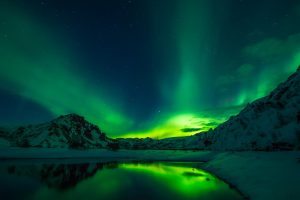
Going north to witness the stunning landscapes Northern Iceland has to offer might seem like a crazy idea during the winters, but trust me when I say this – it isn’t something that should be missed!
You will be encountering numerous lava fields and craters in the area – making you feel like you’ve landed on the moon!
However, road closures are common during the winters so you have to plan your way to the Arctic area!
Some trails might not be accessible due to the weather conditions and some roads might be closed, and so, it would be a great idea to navigate your way to the top with the help of these resourceful websites:
- vedur.is – Updates you regarding the weather conditions
- road.is – Updates you regarding the conditions of the roads
Cloudy skies can make it harder to witness the Northern Lights, but Vedur.is doubles as your guide by locating the Northern Lights for you.
It indicates where the skies are clear and where you can have a spectacular view of the lights, allowing you to plan accordingly.
Also, there will be quite a few natural sites such as the scenic waterfalls and gorgeous trails of Landmannalaugar that may not be accessible during the winters.
It is not advised to plan a trip alone to the Icelandic Highlands, as many have lost their lives due to the abrupt weather changes and harsh weather conditions.
It is recommended to go with guided tours that encompass massive vehicles if you want to witness the exotic landscapes.
My best advice would be to stick to the Ring Road – the one that circles Iceland and connects all the main towns and cities.
This road is quite well maintained even during the peak of the winter season, so the path will most certainly be clear.
5. Tips for Hiking Iceland in Summer

When you go hiking in Iceland in the summer, summer weather is not exactly what they encounter.
This is mainly due to the fact that Iceland has a relative definition for summer, which varies based on the intensity of the temperature drop currently being faced in the location.
Speaking statistically, the temperature is observed to be around 10–13 °C or 50–55 °F during the summer.
The unique aspect of the weather in Iceland is that it is continuously subjected to change during the summer.
On some days it might rain and on other days, it might be quite windy or even hot – debunking the common misconception that it is always cold in Iceland!
Hence when hiking in Iceland during the summer, keeping some useful tips and tricks in mind can definitely make your trip a lot easier!
Before you decide on a trail to hike on, it is best to get your gear and equipment aligned.
- Starting off with the thing that matters most, shoes. The first trip is to always opt for waterproof shoes. Although trails like the glamour waterfall hike tend to remain very pleasant during the summers, it does not excuse the fact that waterproof shoes are a necessity. Usually, the trails offer snowy peaks, or snow at places like the fimmvörduháls trek and the Laugavegur trek, which are quite damp along the trek, making it difficult to maintain a firm grip. Hence waterproof shoes offer a firm grip matched with the luxury of being water repellent. These shoes especially come in handy when freezing cold water on the feet can restrict movement along the trek.
- The second tip is to always wear a thermal shirt. While the weather in Iceland particularly in summer is highly subjected to change, there is no reason why that change should impact your outfit. To put it simply, what might start off as a cool pleasant day might end on a freezing night. Hence keeping essentials like thermal shirts can help add stability to your wardrobe, all the while providing you with insulation against the changing temperatures.
- Next, you would need to bring a first aid kit. While most travelers do so already, hiking in Iceland during the summer is seen as a more risk-free endeavor compared to doing so in the winter. Hence most people overlook the fact of lurking dangers. More importantly, the higher temperature permits partaking in more summer activities, which often result in bruises and bandages.
- Lastly, it is recommended to bring your camera with you to capture the enticing views you will be encountering during your adventure-filled escapade. While due to the summertime, the Northern Lights may not be visible (unless you’re visiting during late August), a lot of the other wonderful and picturesque sights will be ready to be photographed! Hence having your camera gear mounted onto your hat or at your back will work better for you during the summers.
6. Best Hikes in Iceland
Iceland, with its unique geographical formation and a picture-perfect view, is one of the ideal places to be – especially when it comes to hiking!
Hiking in Iceland has long been a source of attraction for the tourists with its set of popular treks and trails.
What may look like heaven on earth in pictures is actually a photograph of the best hikes in Iceland. With its snow-covered peaks and greenery-enriched terrains, Iceland is home to some of the most beautiful locations for hikers and tourists alike.
The immense popularity is credited to its extreme geographical features along with the breathtaking views that it has to offer.
With enough encounters, hiking in Iceland will be one of the fondest memories you’ll ever make!
To name a few, the following are some of the most ideal places to hike on in Iceland:
1.THE ICELANDIC HIGHLANDS

Not to pick favorites, but Icelandic highlands is easily a hiker’s paradise on earth, and not without good reason.
Its breathtaking view leaves many in sheer awe while baffles the rest to their core. The 40,000-square-kilometer field makes this place captivating and home to some of the most adventurous of locations.
From lava-filled volcanos to the highest possible peaks and from endless black desserts to massive glaciers, Iceland is an ideal place to explore!
With a lot to expect on the destination, let’s look at some of the routes to get you there.
Starting with Laugavegur, which is easily a three to five-day hike. The next trail option is the Fimmvörduháls trail, which only takes a day or two at most to complete.
The Kjölur route is also a good option, which takes around two to three days at least.
2. THE WESTFJORDS

The Westfjords is ideal for tourists and hikers who wish to create their own path as they explore the breath-taking Fjord scenery.
Though in comparison, it is the least visited amongst the popular locations. However, this only adds to its beauty, as Hornstrandir Nature Reserve, located in a corner of Westfjords Iceland, is one of the few places that remain untouched by mobile vehicles.
With a lot to expect on the destination, let’s look at some of the routes to get you there.
Rauðisandur is one of the routes to get you there, entailing an adventurous day hike along with exploring the stunning sandy beaches.
Hornstrandir hike is also another route to the same destination, with the difference being a hike of four to six days.
Similarly, Bolafjall Mountain and Dynjandi waterfall are other means to the beautiful end.
3. THE REYKJANES PENINSULA

These treks are worth the hype as they lye majestically on a drift zone, seated perfectly between the North American and the Eurasian tectonic plates.
With its diversity and unique geographical composition, the Reykjanes’ landscapes fan out to multiple hiking trails, which are most definitely worth the visit.
In addition to being beautiful and breathtaking, the Reykjanes’ landscape is one easily accessed by most people hiking in Iceland.
Due to not only the fact that its beauty beckons hikers from far and wide, but also due to the close proximity of Keflavik International Airport.
With a lot to expect on the destination, let’s look at some of the best routes to get you there.
Go on a day hike as you start your journey at the Thornbjorn trail, one that easily provides a mesmerizing panoramic view of exactly what Reykjanes Peninsula truly is!
Krýsuvík geothermal area is another means to an end, which will make you love the journey more than the destination.
The Gunnuhver geothermal area and Reykjanesvegur trail is also a way to enrich your hiking experience.
7. Best Hiking Gear for Iceland
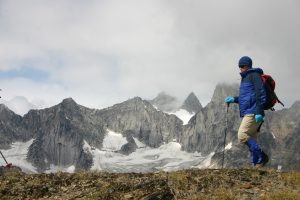
Before you entail on your hiking journey in Iceland, it is important to have the right equipment with you.
To fully enjoy your trip, having the right gear can make all the difference. More often than not, most people only pack the necessaries without lending an ear to the tale of the most essential equipment.
Hence all of the following gears are necessities rather than a luxury when it comes to hiking in Iceland:
- Hiking pants are essential to hiking on the most adventurous of treks. The best part about hiking pants is that they accommodate the trail by allowing ample movement. Another hidden benefit of the hiking gear such as this one is that it is also fast drying, which works great when in need!
- A waterproof jacket is another necessity before you hit the trail. What a water-resistant jacket does is keep the moisture out, making it a travel necessity since the moisture-enriched landscape is bound to dampen your clothes at one time or the other.
- A hat is an important part of your hiking gear to withstand the cold breeze and harsh winds. Covering your head as you entail high altitudes will always work in your favor for a number of reasons, primarily being shielding from changing temperatures and headaches.
- A Lightweight Backpack is your to-go-to item when hiking in Iceland. This makes it easier to carry your equipment far and wide without having to endure the burden of the backpack itself. The key point here is that lightweight can be equivalent to a durable fabric that can withstand the harsh weather conditions.
- A GPS Device is at the top of the list when it comes to having the ideal hiking gear. More often than not, a path you know may not necessarily be equivalent to the path recommended. Hence having a GPS device will work wonders to browse new trails.
- Lightweight Tents and Sleeping bags are additional gear that is absolutely necessary when you plan on camping and hiking in Iceland. The gear not only comes in extremely handy but is also important to revitalize you for the next day.
Hence when you hike to the trails in Iceland, be sure you come prepared to fully enjoy the wonders these stunning landscapes have to offer!
If you’re an outdoor fan and love hiking, here are some more inspiring guides for you:
- Hiking in Tuscany – What To Expect
- An Inspirational Guide To Hiking in Zurich
- Hiking in Bavaria – Stunning Beauty Awaits You!
- The Complete Guide to Hiking in Iceland
- Best Hiking Guide for the UK [England, Scotland & Wales]
- The Complete Guide to Hiking in Iceland
Pin this “Complete Guide To Hiking in Iceland” for later:

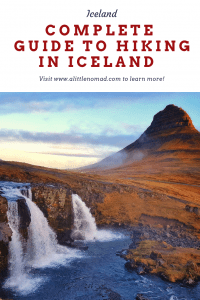
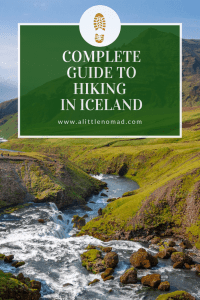

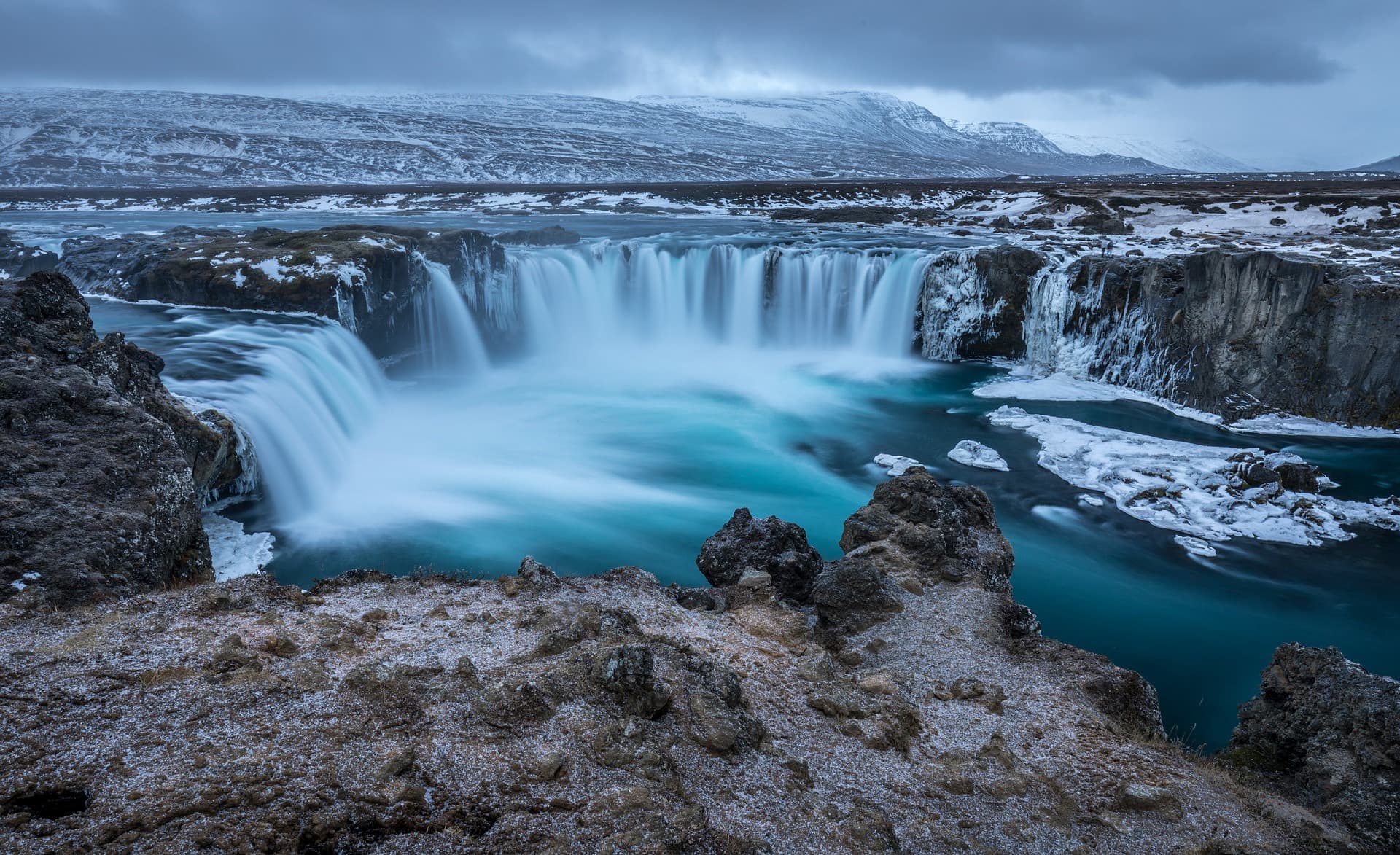



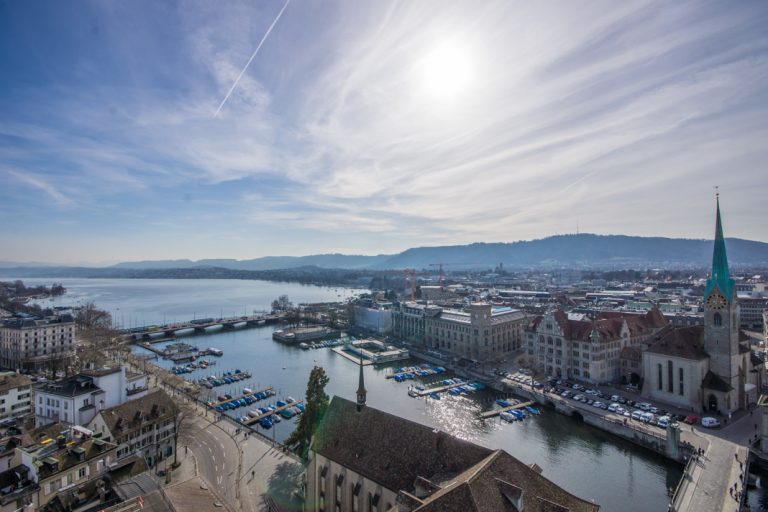


I was in Iceland in the summer. We did the ring road, the golden circle, and western peninsula. We loved our 2-week road trip. I’m planning to go back in the winter to see the northern lights….And I’m damn sure all your tips will help me to enjoy more than my first trip
Hi Kanika, that sounds like a dream itinerary, absolutely amazing!